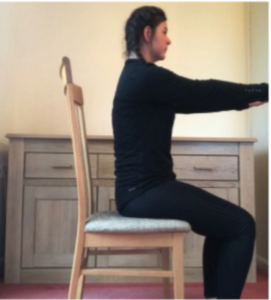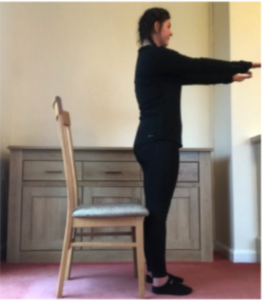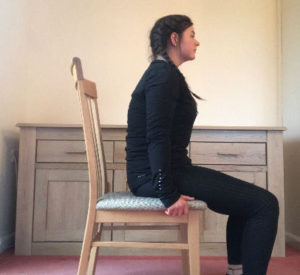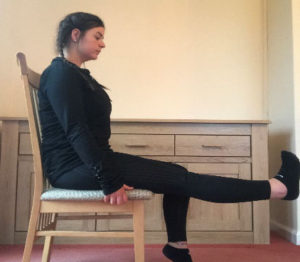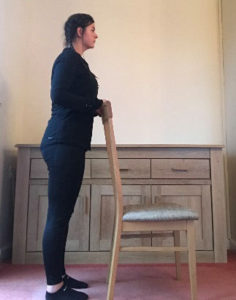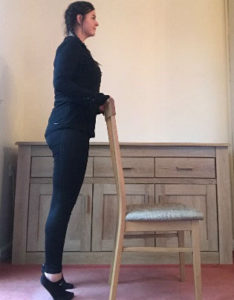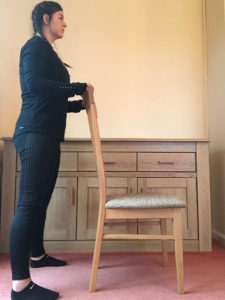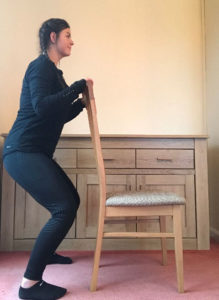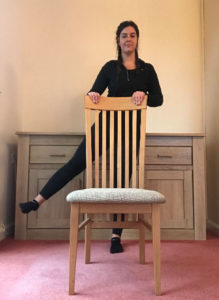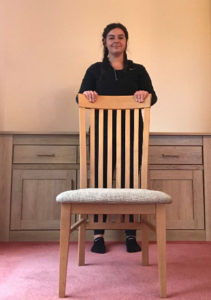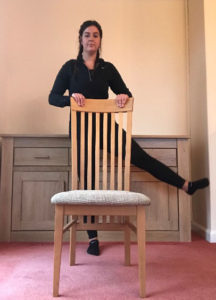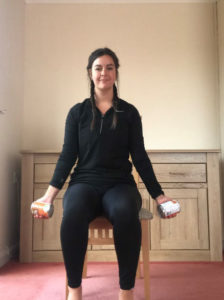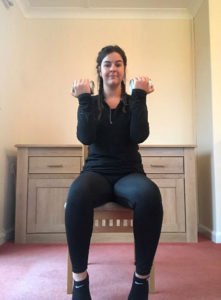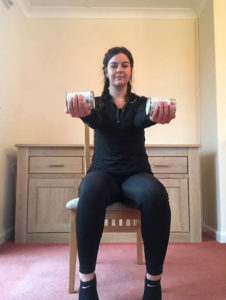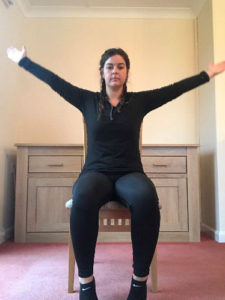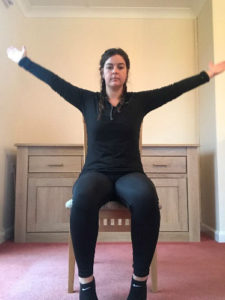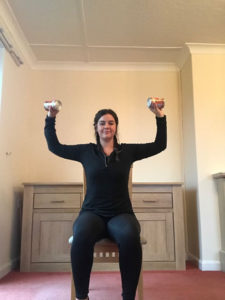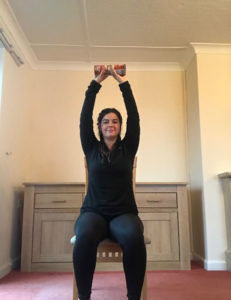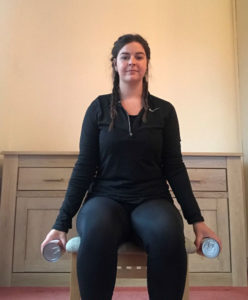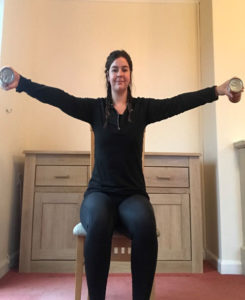Lower and Upper Limb Exercises
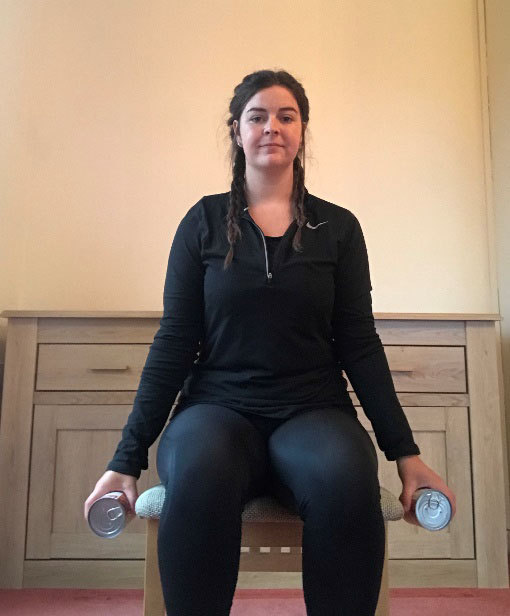
Chair exercises for seniors
Repeat 3 times per week with a 1-day rest
period in-between
1 or 2 Sets
Chair exercises for seniors – Important:
- Never hold your breath while lifting. Inhale before lifting, exhale while lifting and inhale
again while lowering the weight. - Lift the weight slowly through the entire range of movement.
- A little march will help warm you up.
- Prepare a glass of water
- Ensure that the chair you use is stable and sturdy.
- You could use a kitchen worktop or breakfast table for extra support
- Wear comfortable clothes and supportive footwear.
- STOP if you experience pain in joints or muscles.
- STOP if you experience chest pain, dizziness or shortness of breath.
- It’s normal to feel slight muscle soreness the next day
Key Terms
Sets: A set is the number of cycles of reps that you complete.
Reps: A rep is the number of times you perform a specific exercise.
Inhale: Breathing in.
Sit- to- stand from the chair (slow and controlled)
- Sit on the edge of the chair, with feet hip-width apart.
- Lean forwards slightly, then stand up slowly, using your legs, rather than your arms.
- As you stand up slowly, it is important to look forwards, not down.
- Stand upright.
- Slowly sit down onto the chair, then repeat.
Leg Lifts (bent-to-straight)
- Sit on the chair, with your hands gripping the chair either side.
- Lift one leg in a straight position with toes pointing to the ceiling.
- You should feel that the quadricep muscle (arrowed orange is shown in the picture) should feel hard.
- Hold this position for 5-10 seconds, then relax for 3 seconds by bending the knee (shown in the first picture).
- Then repeat 10 times
- Once 10 reps have been completed, do the same with the opposite leg.
Calf raises with or without support
- Stand upright, then push up through the balls of your feet and raise your heels until your standing on your toes.
- Then, slowly lower your heels back to the ground.
- This movement should be slow and controlled.
- Then repeat.
Mini squats- with or without support from a chair
- Place your hands on the back of a chair or a type of secure surface (e.g. kitchen worktop).
- Stand with your shoulder hip-width apart for stability.
- Slowly bend your knees, ensuring your back is straight.
- Aim to get your knees at around your big toe (shown in picture).
- Gently come back up to a standing position, squeezing your buttocks.
- Then, repeat.
Side-ways leg swings
- Place your hands on the back of a chair or a type of secure surface (e.g. kitchen worktop).
- Raise one leg to the side as far and as comfortable as possible.
- Ensuring that your back and hips remain straight (avoid tilting).
- Return to your starting position.
- Then, raise your opposite leg.
- Repeat 10 times on each leg.
Upper Limb Exercises
Bicep curls (either sat on chair or standing)
- Place your hands out by your side, with the palm of your hands facing forwards. If you are standing, stand feet hip-width apart.
- Hold a pair of equal dumbbells’ or an alternative (filled water bottles).
- Slowly bend your arms until the weight in your hands reaches your shoulder.
- Slowly lower arm, back to the starting position and repeat.
Video versions of all of these exercises are available on our YouTube channel
Arm circles clockwise
- This exercise can be completed in either a standing or seated position.
- Place your arms out to the side.
- Circle your arms forward using small controlled movements
Arm circles anti-clockwise
- This exercise can be completed in either a standing or seated position.
- Place your arms out to the side.
- Circle your arms backwards using small controlled movements
Shoulder press
- Bend your elbows to 90 degrees and, keeping elbows in line with shoulders.
- The weights should face towards the ceiling.
- Straighten the elbows to press both weights overhead.
- Repeat these steps in reverse order to lower arms back down to starting position and repeat.
Sidearm raises
- Ensure your back is straight.
- Place your arms down by your sides.
- Slowly lift the weights out to the side until your arms are matching and are at shoulder level.
- Then lower them back
Physical activity tips guidelines:
- Getting up to make a cup of tea
- Moving around your home
- Walking
- Gardening (shovelling or digging or moving regularly)
- Sweeping
- Cleaning and dusting
- Vacuuming
- Making the bed
- Standing up
- Shopping (carrying bags in from a shopping delivery or going shopping)
It is important to:
- Maintain strength
- Keep mobile
- Maintain balance and coordination
- Look after your general well-being
All these components will help an individual to gain more energy.
This is also likely to help someone increase confidence and independence, as it has been suggested that regular exercise can reduce the risk factor of falling in older adults.
Other benefits of keeping active are that most people like to stay in connection with society, such as their friends, neighbours and community.
Therefore, being in your home, in your garden or being active around your local area will help you to achieve this and stay connected with others.
For example, having something to talk about over the phone or via video calls with people, or completing these activities with someone.
This could also involve completing daily activities in the garden with your neighbours or communicating with various people around your local area.
Especially in these tough and challenging times, what better opportunity in being able to find the time to focus on yourself and your health?
Tips on how to walk correctly:
When walking, it is really important to keep your head upright, looking forward.
Doing so will help to focus on standing tall and concentrate on balance and coordination. It is also important to lengthen your back when walking.
This will help to avoid leaning forwards, slouching and hunching, therefore, reducing the risk of any short- or long-term injuries.
The core muscles in the abdomen help you to walk in the way on maintaining balance and stability.
A way to engage your core whilst walking is to focus on pulling your belly button in towards your spine.
Within the human body, the shoulders play a key role in walking posture and techniques.
Therefore, it is essential to try and keep your shoulders loose and relaxed. In order to help you with this, try to bring your shoulders up high, as if you are shrugging, then let the shoulders fall and relax in the right position.
Another key component is to gently swing your arms back and forth at your sides, ensuring to swing from the shoulder joint, rather than the elbow joint.
Finally, one of the most important key roles is to maintain a steady heel-to-toe gait.
This means striking the floor with your heel first, then rolling through your heel to your toe, and pushing out of the step with your toe.
This will help you to lift your feet off the grounded correctly and avoid any flat-footed steps such as the shuffling motion or striking the ground with your toes first
Disclaimer.
The information here does not substitute medical advice – you take responsibility for your own exercise program.
Any changes in your health, mobility, balance, pain or falls – please see your GP.


